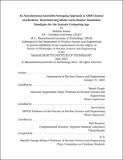An Asynchronous Ensemble-Averaging Approach to CMFD Source Acceleration: Rearchitecting Monte Carlo Reactor Simulation Paradigms for the Exasacle Computing Age
Author(s)
Kumar, Shikhar
DownloadThesis PDF (8.827Mb)
Advisor
Forget, Benoit
Smith, Kord
Romano, Paul
Terms of use
Metadata
Show full item recordAbstract
The safe and reliable operation of a nuclear power plant requires a meticulous understanding of the various physics phenomena at play within the reactor core. Monte Carlo neutron transport methods are commonly used for the purpose of high-fidelity full-core reactor analysis, stochastically sampling a large number of neutron histories throughout the reactor core with minimal approximations to the underlying phase space of the problem. Monte Carlo methods, however, face several issues, primary of which is the prohibitively large number of computational resources required for tallied quantities to reach adequate uncertainty levels for full-core analysis. Advances in High-Performance Computing (HPC) systems and significant code parallelization of Monte Carlo algorithms have helped to reduce overall time to solution. This thesis extends these efforts by proposing a novel ensemble averaged Coarse Mesh Finite Difference (CMFD) simulation strategy in order to improve parallel efficiency on HPC systems while also addressing other issues surrounding Monte Carlo methods including fission source stationarity, real variance calculations, and nonlinear coupling schemes.
This thesis begins by proposing a fission source stationarity diagnostic that monitors the behavior of Functional Expansion Tally (FET) coefficients. This method relies on the efficient computation of meshless quantities that signal whether various spatial modes of the fission source have stopped fluctuating within statistical limits, avoiding issues of false convergence that are prevalent with more commonly used diagnostics that rely on Shannon entropy calculations. This work provides the framework for establishing total runtimes associated with Monte Carlo inactive generations, as well as a heuristic for exact runtime savings from source acceleration methods such as CMFD.
Next, a rigorous sensitivity study of CMFD source acceleration is conducted in order to pinpoint the exact parameters that affect the evolution of Monte Carlo simulations in the inactive and active generations. Here, it is found that coarse CMFD meshes should be used with an expanding windowing scheme that employs a relatively large maximum window size in order to reduce overall runtime while ensuring that variance 3 levels are on par with un-accelerated simulations. Runtime analysis also indicates that a hybrid solution that combined a loosely-converged CMFD solution during initial inactive generations while reverting to un-accelerated Monte Carlo during the later inactive generations should be employed in order to reduce overall runtime to stationarity, continuing to turn off CMFD feedback into the active generations as well.
Finally, a comparison of various Monte Carlo run strategies motivates the development of the ensemble averaged CMFD simulation strategy, which is shown to be the optimal simulation paradigm on large-scale computing systems. From the perspective of parallel efficiency, ensemble averaged CMFD is shown to improve load balancing by 5-10% on representative 1-D, 2-D, and 3-D reactor problems, while the use of an aggregate seed stopping criteria ensures that initial error levels converge at ideal 1/ p N rates, where N is the total number of Monte Carlo ensembles simulated in parallel. Ensemble averaging also provides a simple and accurate method for calculating real variance estimates across statistically independent ensembles of neutrons, something that is not typically possible with single seed Monte Carlo simulations. Moreover, the asynchronous ensemble averaged CMFD implementation provides better fault tolerance against possible node failures on large-scale computer facilities. Finally, arguments for how ensemble averaging can be applied to nonlinear multiphysics coupling schemes as well as Graphics Processing Unit (GPU)-based computer systems are also presented.
Date issued
2021-06Department
Massachusetts Institute of Technology. Department of Nuclear Science and EngineeringPublisher
Massachusetts Institute of Technology